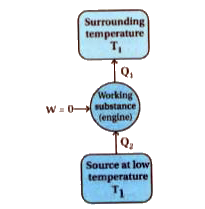Write an example in which the first law of thermodynamic is allowed but never be observed.Solution in Gujrati
For this an example is given below.
Nobody has ever seen a book lying on a table jumping to a height by itself. But such a thing would be possible if the principle of conservation of energy were the only restriction.
The table could cool spontaneously, converting some of its internal energy into an equal amount of mechanical energy of book, which would then hop to a height with potential energy equal to the mechanical energy it acquired. But this never happens.
Hence, principle which disallows many phenomena consistent with the first law of thermodynamics is known as the second law of thermodynamics.
The second law of thermodynamics gives a fundamental limitation to the efficiency of a heat engine and the coefficient of performance of a refrigerator.
The efficiency of a heat engine η=1=Q2Q1, can never be unity, mean never be 100%, because heat released Q2 to the cold reservoir (sink) can never be made zero. Means absorbed Q1 cannot converted completely into work.
For a refrigerator, the second law says that the coefficient of performance can and never be infinite. Because in α=ΔQW , external work (W) can never be zero, suppose it zero then a is infinity but external work cannot be zero.
From this scientists Kelvin-Planck and Clausius gave the statements for second law of thermodynamics which are as follow :
(1) Kelvin-Planck Statement : No process is possible whose sole result is the absorption of heat from a reservoir and the complete conversion of the heat into work. For this schematic representation is given in below figure.

(ii) Clausius Statement : No process is possible whose sole result is the transfer of heat from a colder object to a hotter object. For this schematic representation is given in below figure.

Topper's Solved these Questions
- THERMODYANMICS BOOK - KUMAR PRAKASHANCHAPTER - THERMODYANMICS EXERCISE - Section-A (Try Your self )
90 Videos
- THERMODYANMICS BOOK - KUMAR PRAKASHANCHAPTER - THERMODYANMICS EXERCISE - Section-B Numericals (Numerical From Textual Exercise)
10 Videos
- THERMAL PROPERTIES OF MATTERBOOK - KUMAR PRAKASHANCHAPTER - THERMAL PROPERTIES OF MATTEREXERCISE - Question Paper (Section - D) (Answer following in brief :) Each carry 4 marks
1 Video
- UNITS AND MEASUREMENTBOOK - KUMAR PRAKASHANCHAPTER - UNITS AND MEASUREMENTEXERCISE - Section -F (Questions from Module )
20 Videos
Similar Questions
Which form of heat believed in before the modern time ?
View SolutionA geyser heats water flowing at the rate of 3.0 litres per minute from 27∘ C to 77∘C. If the geyser operates on a gas burner, what is the rate of consumption of the fuel if its heat of combustion is 4.0×104 J/g ?
View SolutionIn an experiment on the specific heat of a metal, a 0.20 kg block of the metal at 150∘C is dropped in a copper calorimeter (of water equivalent 0.025 kg) containing 150 cm3 of water at 27∘C. The final temperature is 40∘C. Compute the specific heat of the metal. If heat losses to the surroundings are not negligible, is your answer greater or smaller than the actual value for specific heat of the metal ?
View SolutionIf the error in measurement of radius of a shpere is 2% then the error in determination of volume of the sphere will be …………
View Solutionउष्मागतिकी के प्रथम नियम को बताइए तथा इसका गणितीय रूप लिखिए । उष्मागतिकी के प्रथम नियम से रुद्धोष्म प्रक्रिया को समझाइए ।
View Solutionऊष्मागतिकी का प्रथम नियम लिखिये।
View Solutionऊष्मागतिकी के प्रथम नियम को सूत्र के रूप में लिखिये।
View SolutionWrite the mathematical form of the first law of thermodynamics.
View SolutionWrite the mathematical form of the first law of thermodynamics.
View SolutionWhat is the limitation of the first law of thermodynamics?
View SolutionWrite the equation of the first law of thermodynamics.
View SolutionWrite and explain the first law of thermodynamics.
View SolutionWrite the first law of thermodynamics.
View SolutionWrite the limitations of first law of thermodynamics.
View SolutionWrite the first law of thermodynamics in isothermal expansion.
View Solution
